रणबांके राठैड़ों की इस गौरवशाली ऐतिहासिक तपोभूमि सूर्यनगरी जोधपुर में जहां संसार की अद्भुत भौगीशैल परिक्रमा की जाती है,
कहते हैं इन पहाड़ियों की श्रृंखलाओं में अनेकानेक महान् तीर्थ स्थल रहे हैं, जहां एक समय शिव भगवान भी निवास करते है।
यहां किसी समय सरस्वती नदी बहती थी,
ऐसी इस पावन स्थली में जहां संस्कृति,
कला, रहन-सहन और आपसी प्रेम के के बीच यहां के लोगों की सादगी व अपनत्व का आदर झलकता है,
चारों तरफ फैले रेगिस्तान के कारण प्राचीन काल से इस प्रदेश को मरूप्रदेश, मरूस्थली, मरूमेदिनी तथा मरूकान्तर जैसे शब्दों से पुकारा जाता रहा है, कालान्तर में यही मरूप्रदेश मारवाड़ के नाम से विख्यात हुआ।
जिसे देखकर हिन्दुस्तान के बादशाह शेरशाह सूरी को 1544 ई. में गिरी-सुमेल युद्ध के पश्चात् कहना पड़ा- ’’एक मुट्ठी भर बाजरे के वास्ते हिन्दुस्तान की सल्तनत खो देता।’’
इतने निर्जल प्रदेश के लोग जिन्हें मारवाड़वासी कहा जात है,आपका हृदय के अन्तर्मन की गहराइयों से स्वागत करते हैं, अभिनन्दन करते हैं।
यहां के दोहों-गीतों में गया जाता है कि -
साजन आया हे सखी,
कांई मनवार करां।
थाळ भरा गज मोतियां,
ऊपण नैण धरां।
घर पर जब मेहमान आता है तो यहां के लोग उसका स्वागत अपनी पलकें (आंखें) बिछाकर करते हैं। मेहमान को सर आंखों पर रखा जाता है, यह स्थान ललाट होता है, जहां भगवान का निवास मानते हैं और यही स्थान मेहमान को दिया जाता है, इसलिये जोधपुर में घर आये मेहमान को देवता तुल्य समझा जाता है।
मारवाड़ की भूमि वीर पुरूषों व वीरांगनाओं के त्याग और बलिदान से भरी पड़ी है। यहां के गढ़-किले इनके साक्षी हैं। काल से ग्रसित इस भूमि के लिये वीरों व वीरांगनाओं ने जो त्याग और बलिदान किया, उसे भुलाया नहीं जा सकता।
वीरभूमि मारवाड़ का इतिहास अत्यन्त गौरवशाली रहा है। इस भूमि ने सीमान्त प्रदेश होने के नाते राष्ट्र के सीमा प्रहरी होने का दायित्व बखूबी निभाया है। इस क्षेत्र से गुरजकर जिन विदेशी आततायियों ने भारतभूमि को रौंदने का दुस्साहस किया, उनका वीरों ने हर बार जबरदस्त मुकाबला किया।
इसलिए कहा भी जाता है-
ना निपजे केसर अठै,
ना हीरा निपजंत।
सिर कट्या जूंझै जिके,
इण धरा उपजंत।।
वीरां री काशी अठै,
सूरां रो हरिद्वार।
पग-पग असिधार तीर्थ,
बही षोणित गंगधार।।
यहां के राजपूतों के शौर्य और वीरता से प्रथावित होकर अमीर खुसरो ने लिखा- ’’वे राजपूत गजब के साहसी और बहादुर थे। उनके सिर के टुकड़े-टुकड़े हो गये फिर भी वे युद्ध स्थल पर डटे रहे।’’
अब यह नगर राजस्थान राज्य का दूसरा बड़ा शहर है। जोधपुर जिला उत्तर से दक्षिण में लगभग 205 कि.मी. की लम्बाई में तथा पूर्व से पश्चिम में 211 कि.मी. की चैड़ाई में स्थित है।
इस जिले का कुल क्षेत्रफल 22,850 वर्ग कि.मी. है। इसका ज्यादातर भाग रेगिस्तान है तथा यहां की जलवायु शुष्क व गर्म है।
अक्टूबर से मार्च तक सर्दियों का मौसम होता है।
अतः पर्यटन के लिये यही समय अनुकूल है।
जोधपुर की स्थापना राव जोधाजी ने 12 मई 1459 में की थी। इसलिए इसका नाम उन्हीं के नाम पर जोधपुर रखा गया तथा पर्यटक इसे सूर्यनगरी औ ब्ल्यू सिटी के नाम से भी पुकारते हैं।
हम इतिहास में झांककर देखते हैं तो पाते हैं कि जोधपुर के शासकों का इतिहास बड़ा ही गौरवशाली रहा है। मारवाड़ की मिट्टी सूरवीरों को पैदा करने में विशेष उपजाऊ रही है। जैसा कि कर्नल टाॅड जैसे विदेशी इतिहासकार ने भी गर्व के साथ लिखा है कि ’’मारवाड़ का ऐसा कोई गांव नहीं जिसमें सूरवीरों की स्मृति में बना हुआ कोई स्मारक न हो या ऐसा कोई गढ़ या किला नहीं जिस पर न्यौछावर हुए वीरों की यशगाथा सुनाने वाला कोई प्रचलित किस्सा न हो।’’
जोधपुर तो सैंकड़ों वर्षों से एक तीर्थ नगरी की भांति पूजनीय रहा है। यहां पर चार ज्योतिर्लिंगों की तरह से चार धाम मण्डलनाथ, सिद्धनाथ, बैजनाथ तथा भूतनाथ प्राचीन काल से ही स्थापित थे,
जिनका वर्णन अनेक संस्कृत ग्रंथों में मिलता है।
न जाने यहां की पहाड़ियों की गुफाओं में कितने ऋषि-मुनियों ने तपस्या करके अपने लोक-परलोक को सुधारा। मारवाड़ की प्राचीन राजस्थानी मण्डोर तो सूरवीरों व तपस्वियों का अभेद्य गढ़ रहा है।
ऋषि माण्डव्य ने मण्डोर क नींव रखी तथा कई राजवंशो ने इसके झरोखे में बैठकर शासन किया और अपने हुक्म चलाये।
सबसे प्राचीन नागवंशी शासक के वक्त के जलस्त्रोत उनकी स्मृतियों के रूप में नागादढड़ी नागगंगा, नागकुण्ड आदि के नाम से आज भी मौजूद है। नागवंशी शासकों की भांति कई छोटे-बड़े राजवंश शासन करते हुए काल-कवलित होते गये। फिर पड़िहारों का शासन हुआ, इनमें एक से बढकर एक शूरवीर व यशस्वी शासक हुए।
मानसार शिल्पशास्त्र describes about Mountain Forts (गिरिदुर्ग) as follows:
पर्वतावृतमध्ये पर्वतस्य समीपके ।
पर्वताग्रप्रदेशे तु गिरिदुर्गमिति त्रिधा ॥
Mountain Fort is of three kinds, namely, as surrounded by a mountain, near (at the foot of) Mountain and other on top of mountain.
 |
| On 03 Aug 1984,India Post issues a commemorative postage stamp on the Jodhpur Fort |
With imposing bulwarks and ramparts of the UNESCO-inscribed Mehrangarh Fort, Jodhpur, Rajasthan State of India. The fort may not be as spread out as Kumbhalgarh or Amer, but it does seem unassailable.
This giant fort of the fifteenth century is situated on the rocky hill, 125 meters high from the ground, surrounded by a ten-kilometer long high wall with eight doors and countless towers. There are four gates connected to the invisible, winding roads from the outside. Inside the fort, there are many grand palaces, wonderful carvings, latticed windows, and inspiring names.
Notable among these are the Moti Mahal, flower palace, shish mahal, sileh khan, Daulat Khan, etc. These palaces contain an astonishing collection of furnishings of Indian cuisine. Apart from this, there is also a wonderful collection of patrons, elephants, small paintings of different styles, musical instruments, costumes, and furniture.
A royal Rajput procession, a mural at the fort at Jodhpur, Rajputana.
This the Fort is one of the oldest fortresses of India and is a symbol of India’s rich past. Rao Jodha was one of the 24 children of King Rampal of Jodhpur.
He became the fifteenth ruler of Jodhpur. After one year of taking over the regime, Rao Jodha felt that the fort of Mandore was insecure. He wanted to build a new fort on a hill 9 kilometers away from his then Mandor Fort, which was known as Bhor Chidiatunk because there were quite a few birds.
Rao Jodha Ji's statue at Mehrangarh Fort, Jodhpur
On 12 May 1459 AD Rao Jodha laid the foundation of this fort on this hill. Maharaj Jaswant Singh (1638-78) completed this. Originally the seven gateways (pole) of the fort (the eighth door is hidden). On the first door, the tacky nails are used to protect from the attack of elephants.
In the second gate, the Jayapol gate was constructed in 1806 after Maharaj Man Singh got his victory over Jaipur and Bikaner. The construction of the Fateh Pol or Vijay Darwaza was done by Maharaj Ajit Singh in memory of his victory over the Mughals.
On the astrological consultation of astrologer Ganpat Dutt on the foundation of Mehrangarh Fort, Jyeshtha Shukla Ekadashi (accordingly, 12 May 1459 AD) was kept Rao Jodha who incredibly revered in Chamunda Mata.
Chamunda is the Kuldevi of the rulers of Jodhpur.
In 1460, Rao Jodha built a temple of Chamunda Mata near Mehrangarh Fort and established the idol.
Chamunda’s mother was not only the rulers but Kuldevi of all Jodhpur residents and even today millions of people worship this goddess. Special puja is celebrated in the days of Navratri.
The story of the Mehrangarh Fort of Jodhpurbegins with a curse.
There was once a King and like all self-respecting kings of his time, he wanted a grand and imposing fort at an impressive location. One day, he came across the location of his dreams — an isolated hill. The King ordered his men to immediately clear the hill of inhabitants and lay the foundations for the construction of the fort.
Only one man lived on the hill — a man considered holy by the local people around and known as Chidiyawale Baba. He was called thus as he took care of birds and fed them and spoke to them. Chidiyawale Baba was so furious at being evicted from the hill that he cursed the King with recurrent drought in his kingdom. Shaken and now contrite, the King went to Chidiyawale Baba to ask for forgiveness and to request him to cancel the curse. The Baba said that words once uttered could not be taken back, but the effect of the curse could be reversed if a selfless sacrifice was offered. In other words, someone had to volunteer to die by being buried alive on the hill.

The memorial of selfless warrior, Rajaram Meghwal, who volunteered to die.
The King came away dejected as he did not think anyone would volunteer. But that very evening, a man by the name of Rajaram Meghwal presented himself before the King and volunteered for the deed. A relieved King accepted and on an auspicious day and time and at an auspicious site on the hill, Meghwal was buried alive. Rao Jodha, the King, then laid the foundation to building the Mehrangarh Fort in 1459.
Rao Jodha ji(1438-89), one of the greatest rulers of Rathore clan and founder of Jodhpur city, formed an alliance with several Rajput clans like Deora's and Bhati's & attacked & defeated Delhi sultante, capturing Merta, Phalodi, Pokran, Bhadrajun, Sojat, Jaitaran, Siwana, Nagaur and Godwar from the Delhi Sultanate. These areas were permanently captured from Delhi and became a part of Marwar, making it 1 of the powerful state of Rajputana.
Rao Jodha ji made a treaty & tactical alliance with Rana Kumbha, the treaty came to known as 'Awal-Bawal ki Sandhi' in 1453. The treaty aimed at recognition of power of Rao Jodha in Rajputana and taking on of muslim sultanantes around Rajputana in Gujarat and Delhi.

Rana Kumbha's grandmother Hansa Bai was aunt (Bua sa) of Rao Jodha. Hansa Bai played an important role in formation of this alliance. Rao Jodha ruled from Mandore before foundation of Jodhpur but by 1459, it became evident that a more secure headquarters was required. Chidia-tunk, a high rocky ridge, nine km to the south of Mandore was chosen for the new city of Jodhagarh (Mehrangarh). Jodhagarh was on the important Delhi to Gujarat trade route and it greatly benefited from the trade of silk, opium, sandalwood and copper, hence suffered repeated attacks from Delhi Sultanates. Mehrangarh Fort, situated on a 125 m high hill, provided an important stronghold for the Rathores, and became one of the most impregnable forts of Rajasthan.
Rudyard Kipling famously said the following lines about Mehrangarh fort once:
“It's palace that might have been built by Titans and colored by the morning sun”

Mehrangarh Fort is built on a hillock of rhyolite columns that rises 400 feet above the surrounding plains.
The city of Jodhpur grew and developed around the Fort, which has been the headquarters of the Rathore clan that ruled this area for over 5 centuries.
Generations of the royal family lived here, sometimes moving out of the Fort, but mostly living within.
The Fort has lived through occupation, sieges from neighbouring kingdoms and what not.
Mehrangarh, which means ‘Fort of the Sun’, is over 500 yards long making it one of the largest forts in India.
At its highest, the fort rise to 120 feet and at its thickest it is about 70 feet. Yes, it is a formidable fort all around and dominates the landscape. Mehrangarh is built in such a way that it looks like the hillock has sprouted the Fort.
Visitors to Mehrangarh Fort enter through the Jai Pol, which was built in the 19th century by Maharaja Man Singh.
This gate was not the main gate then and was only used as an outer rear gate.
The original main gate to the Fort is hardly used and the popular tourist trail actually bypasses that access road.

Sati Handprints
The widowed women would come bedecked in their jewels and finery and pass through the palace doors and fort gates for the last time. As they left, they would leave a vermilion stained hand imprint on the wall for posterity.
A silent procession would follow the women to the temple where they would give away their jewellery and then proceed to the join their dead husbands on the funeral pyre. The women would not scream or cry as the flames burned them alive.
 |
Imriti pol
|
Since the Fort and the various buildings inside were built over 500 years, the architectural styles vary and it’s quite fascinating to see the buildings from different periods existing side by side.
The different gates, guardrooms, chowks, palaces, and so on are a visual testament to the building history of the last 5 centuries and the influences that shaped them.
After the Foundation was laid in 1459, the first phase of building activity was during the reign of Maldeo (1531-62). The next phase of major construction happened after 2 centuries during the rule of Maharaja Ajit Singh (1707-24), followed by a phase of construction during the reign of Takhat Singh (1843-72). The final, brief, phase was during Maharaja Hanwant Singh’s rule (1947-52).
The ornately carved palaces hold some of the most stunning treasures that one will saw in Rajasthan—silver howdahs, silver and gold palanquins, miniatures, paintings, swords, jewellery boxes, cradles and cribs…
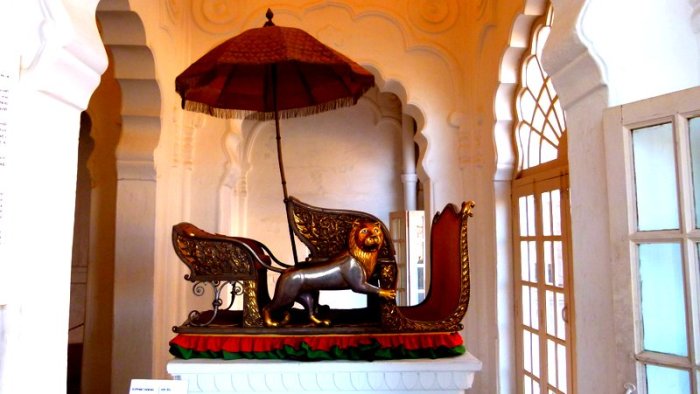
Silver Elephant Howdah

A peacock shaped open palanquin
A royal cradle

The Phool Mahal

The blue Brahmapuri
It is from Mehrangarh Fort that one can see and understand why Jodhpur is called the blue city.
Brahmapuri or the city of brahmins shimmers a startling and enticing view from the Fort. At one point only brahmins could live in Brahmapuri and were also the only community allowed to paint the exteriors of their houses this color.
The blue, so characteristic of Jodhpur, is derived from indigo and acts as a heat and mosquito repellant. But as one will find out on visit, Mehrangarh Fort doesn’t just offer views of the blue city of Jodhpur; it has a lot of stunning blue to offer within the Fort complex itself.

Detail from a painted arch above a doorway at the Chokhelao Mahal

Detail from a painted ceiling at the Khwabgah
Mehrangarh Fort caters to all kinds of tourists and does it rather well without letting anyone feel left out. There are activities like ‘how to tie a turban’ to ‘how to play chess’ to folk music performances to having your palm read, etc.
The Fort offers quiet spots for contemplation and fantastic photo-ops for the serious or click-happy photographer. As for those interested in culture, design and history, the Fort offers it all and there can’t be a better place than Mehrangarh. The Fort employees are courteous and polite, but firm with the more ‘exuberant’ tourists. The Fort is clean and there is adequate water and food available. We have no hesitation in saying that this is the best maintained and managed of all the Forts in Rajasthan.
It is well maintained because it is still managed by Jodhpur Royal family not democratic gov babus. And Make no mistake, Mehrangarh fort is absolutely huge.
Shringar Chowk and Daulat Khana
Shringar Chowk is the first courtyard you come to. In one corner is a marble throne, where the new ruler of Jodhpur is presented to its people, the last being Gajaraj Singh II.
Immediately the quality and detail of the Jali work goes up a level from what can be seen on the exterior of the fort.
The Daulat Khana is a three storey building with arched openings on all levels. Built in early 18th century by Ajit Singh and known back then as Ajit Vilas, its present name literally means “Wealth Store” and is a term that is often used to indicate a treasury, but sometimes the most prestigious royal apartment.
This room is now used for the display of some of the museum’s prize exhibits.
Howdah Room
In this room there is a wonderful collection of 18th and 19th century howdahs (seats for riding on elephants), decorated with some fine silver repousse work.
These elephant seats from the Royal Collection are regarded as the finest in the country.
A priceless and unique historical Howdah is a silver one presented to the Maharaja Jaswant Singh I (1638-78) by the Mughal Emperor Shahjahan.
Palki Khana
Palanquins (litters) were a popular means of travel for royal and noble ladies up to the second quarter of the 20th century. They were also used by men on very special occasions.
This gallery displays one of the richest collections of palanquins in Rajasthan.
View just beyond Shringar Chowk
Before exploring too many more rooms in the fort, be sure to find an open platform just beyond Shringar Chowk that gives some wonderful views over the SW, including the old (blue) city,
and Jaswant Thada.
One find quite a few visitors here, which is a shame as it offers some of the best views of the wider landscape possible from the fort.
Daulat Khana (Treasury)
Star of the show here is Mahadol, a golden palanquin that was a gift from the governor of Gujarat in 1730 A.D.
Where Maharaja Abhai Singh defeated the mughals in the Battle of Ahmedabad 1730 and ruled there. he plundered the Mughal city of Ahmedabad and built the Phool Mahal in Mehrangarh Fort with that wealth and Some of that loot is displayed at Mehrangarh including the golden palanquin of salabat khan. the defeated mughal's name was sarbuland khan.
(sar(not so)buland anymore.. His golden palaquin in Mehrangarh in above pic)
There are numerous display cabinets in this room, displaying items such as heavily decorated swords which perhaps were more ceremonial than functional at the time.
Late 17th Century Katar decorated with verses from the Ramayana using gold.
Mehrangarh Fort Museum, Jodhpur.
Mawar Paintings
In another room is a gallery displaying a large collection of miniature painting, and perhaps the finest collection of paintings from the Marwar School.
Court painting in Jodhpur developed greatly during 17th century through the association of Marwar Rulers with the Mughal Rulers.
During the 18th and 19th centuries it evolved into a distinctive Rajasthani style, combining Mughal naturalism with local folk style and bold colours.
Jodhpur paintings later took on an even more exuberant turn under Maharaja Man Singh (1803-43), and dozens of paintings of the ruler, his nobles and his ladies were made.
Also housed here is an idol of the goddess Gangaur, one of the incarnations of Parvati. Gangaur is worshiped by married ladies for longevity of their husband’s life and my unmarried girls for a suitable match. This silver idol is dressed in traditional Rajasthani costume and jewelry from the 19th century.
This concludes the tour of the downstairs for now, and it’s time to gain some altitude…
Sheesh Mahal (Hall of Mirrors)
This was Maharaja Ajit Singh’s bed chamber, heavily decorated with mirror work.
Under the arches are painted gesso panels of sacred subjects: Brahma, Shiva with Parvati, Devi, Krishna and Ganesh all sit enthroned,
while in other panels Krishna plays the flute and lifts mount Govardhan; and Rama and Sita confer with Hanuman.
Phool Mahal (Flower Palace)
This is a grand and highly ornamented reception room, constructed by Abhay Singh, son of Ajit Singh, in the mid 18th century.
This elevated room is less accessible and would not have been used for receiving outside visitors. It was probably intended as a private audience hall, where the ruler could confer with his confidants and perform certain personal rituals.
Being open to the breeze, the room could also have served for some leisure pursuits such as listening to music.
The architectural style of the interior is derived from the palaces of Shah Jehan, although the outer casing with elaborate jaali work is typical of this part of Rajasthan.
The paintings of the columns and walls are original, but the ceiling and its cornice were repainted in the mid 19th century, in the reign of Takhat Singh.
Takhat Niwas
This has to be one of the most remarkable interiors in Rajasthan, and was the personal apartment of Takhat Singh (1843-1872).
It is an unusually large space: there is no need for supporting columns in the centre as the ceiling is carried on great wooden beams that are in turn supported by engaged piers and corbels on the side walls.
All the surfaces including the floor are painted. Even the windows are filled with coloured glass panes, creating quite an eerie light.
This is also a great location to get more views of the fort and the blue city from an elevated height.
From here the tour takes you through a couple of empty rooms and corridors and a small courtyard with yet more of that amazing carved jali work.
Jhanki Mahal (Peeping Palace)
Situated on the upper floor of the north wing, from the Jhanki Mahal women could look down on the activities of the courtyard down below.
The room now houses a collection of baby cradles.
Zenana Deodi (Palace of Women)
Quite rightly, the tour saves the most impressive architecture for the end of the tour.
This is also the oldest part of the palace complex.
The small courtyard is surrounded by the most exquisite jali carved screens and balconies you could ever imagine seeing,
in the lighter yellow sandstone.
Moti Mahal (Pearl Palace)
Moti Mahal takes its name from the quality of the lime plaster used, mixed with finely crushed shells, it give the surfaces of the room a pearl-like luster.
The five deep alcoves on the far side of the room look like decorative architectural features, but they are actually secret balconies. From here the Maharaja’s queens would sometimes sit and silently listen in on court proceedings.
Final Courtyard
The tour concludes in a final courtyard, with yet more wonderful carved architecture surrounding you.
It’s a perfect spot to take a rest before moving on (shopping opportunities await you at the exit!).
There’s also some hidden gems in this courtyard if you take the time to find them, such as a painted door sitting in the corner with faded panel scenes.

 The memorial of selfless warrior, Rajaram Meghwal, who volunteered to die.
The memorial of selfless warrior, Rajaram Meghwal, who volunteered to die.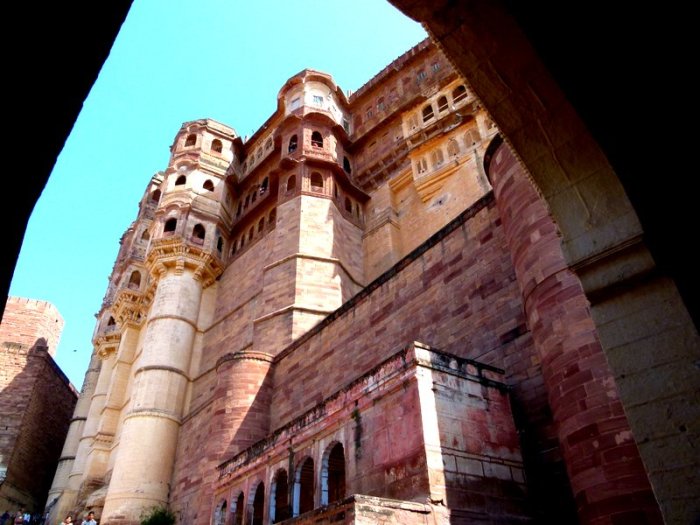

 Sati Handprints
Sati Handprints

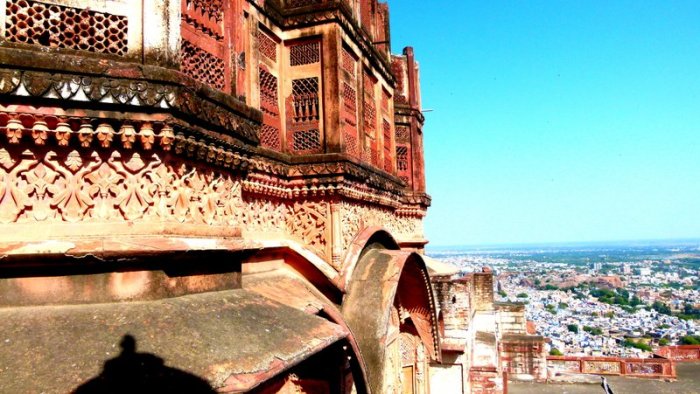

 Silver Elephant Howdah
Silver Elephant Howdah A peacock shaped open palanquin
A peacock shaped open palanquin
 The Phool Mahal
The Phool Mahal The blue Brahmapuri
The blue Brahmapuri Detail from a painted arch above a doorway at the Chokhelao Mahal
Detail from a painted arch above a doorway at the Chokhelao Mahal Detail from a painted ceiling at the Khwabgah
Detail from a painted ceiling at the Khwabgah









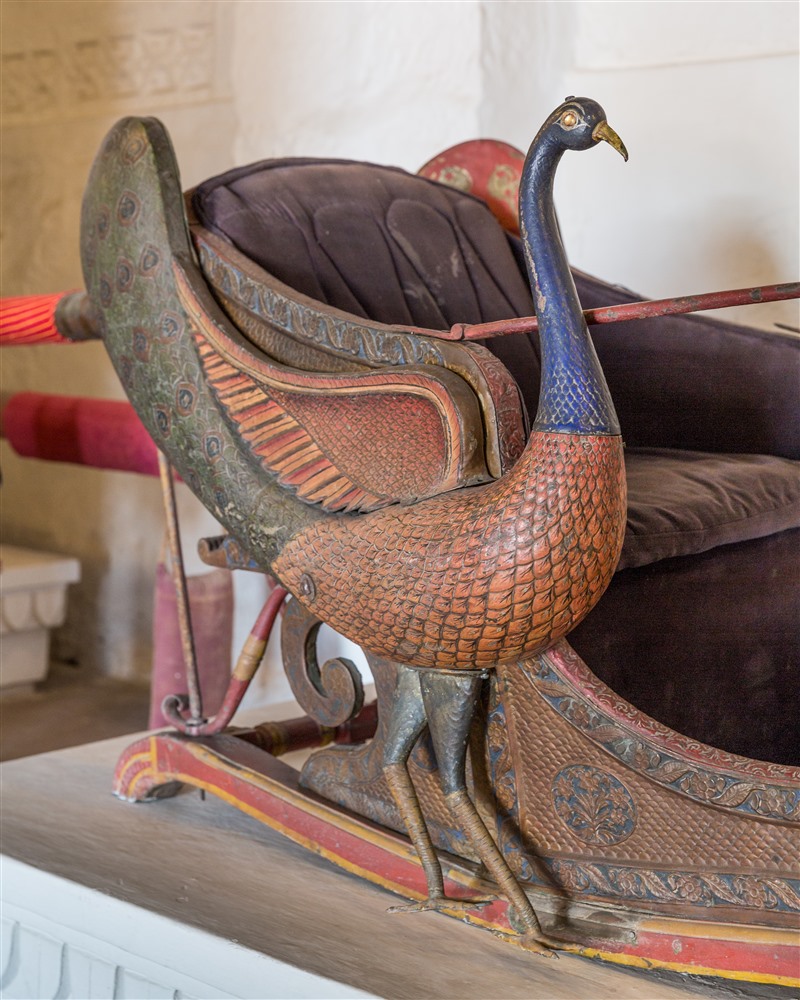











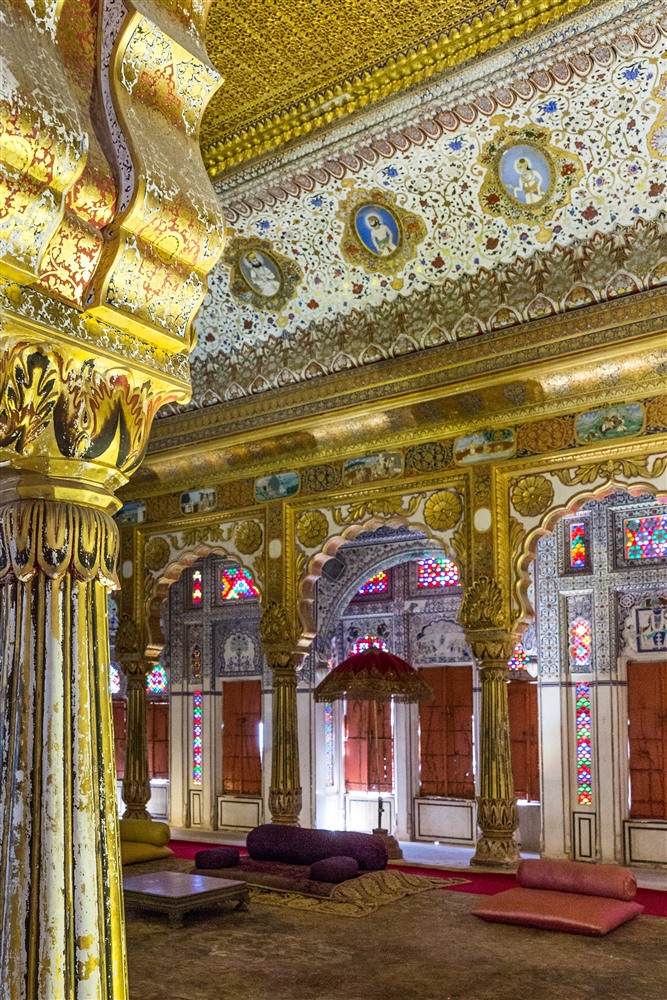




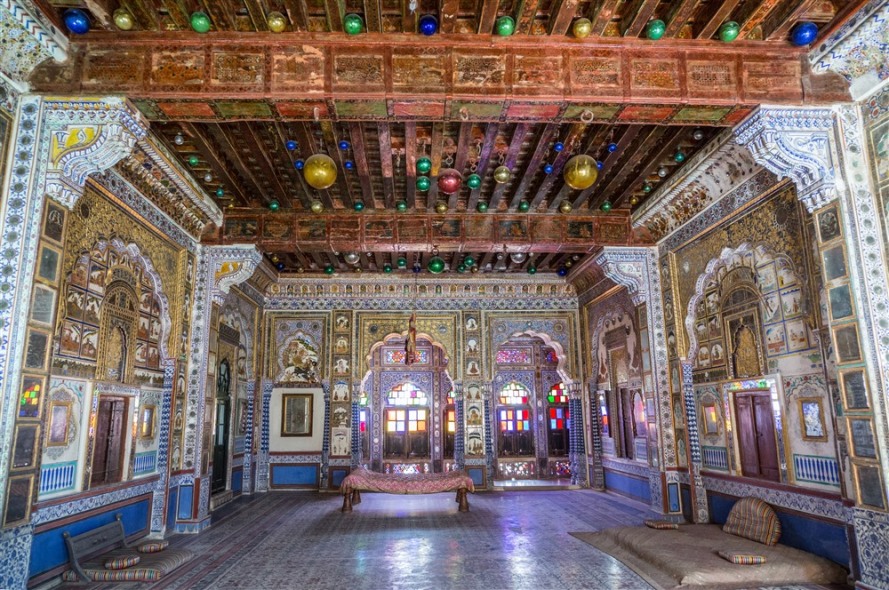




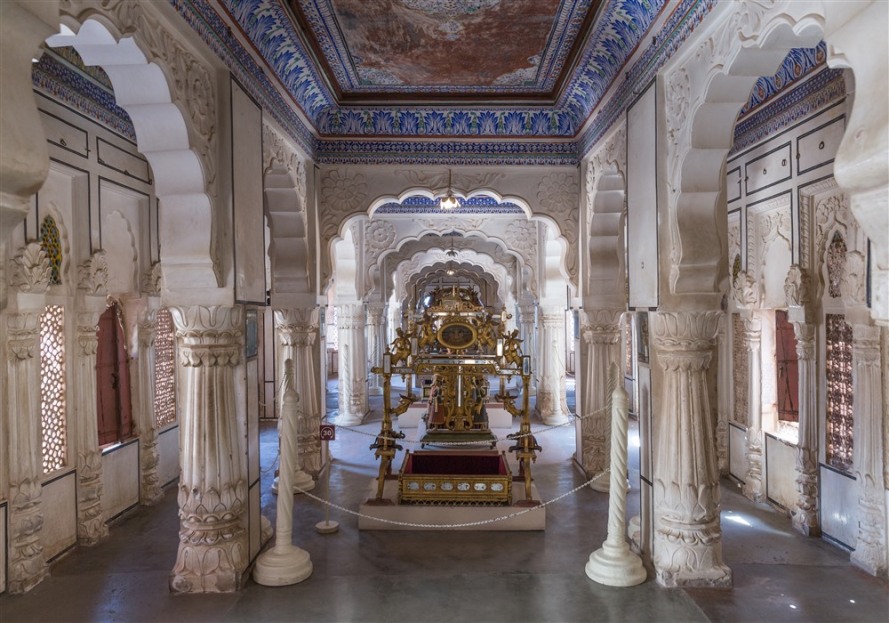


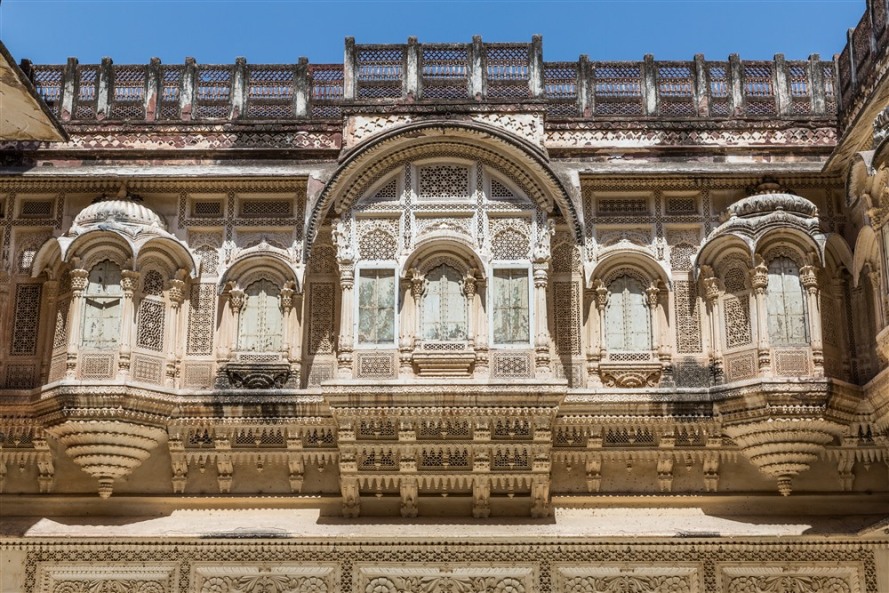









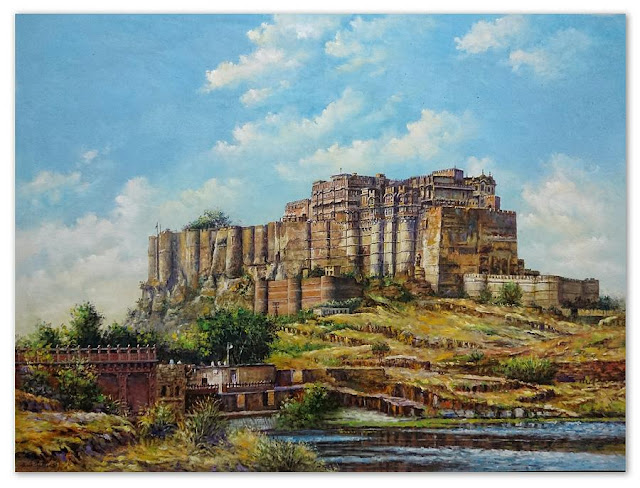





















































No comments:
Post a Comment